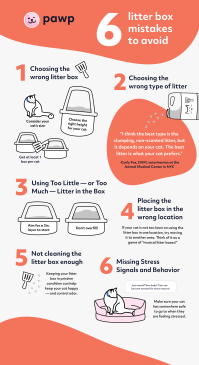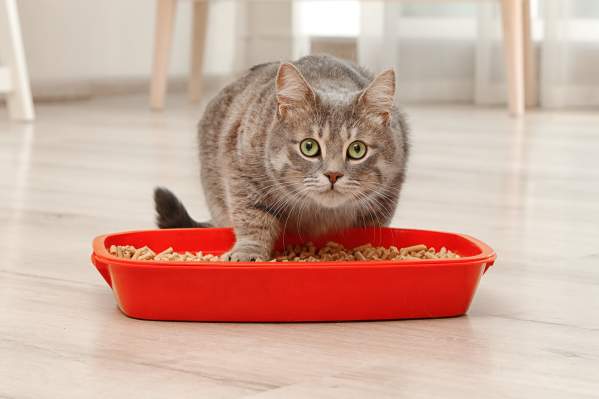Have you ever watched a YouTube video showing one of those smarter-than-average kitties that can use and flush the toilet? If you can't even get your cat to use the litter box, you might be wondering what you are doing wrong.
Perhaps you've had some success with getting your cat to use the litter box. Maybe you're thinking about bringing a litter box into your home for the first time. The good news for worried pet parents is that there are many tried and tested ways to get your cat to go potty in the right place at the right time.
Fix these common litter box mistakes (faux-paws?)
If you're experiencing litter box issues, we've got you covered. Here are some of the most common mistakes — and how to fix them.
1. Choosing the wrong litter box
Cats can be fussy, so finding the right litter box may take some time. Follow these steps to choose the right litter box for your cat:
Consider the size of your cat. A litter box should allow your cat to turn around easily. If the box is too small, your cat may refuse to use it or urinate over the edge onto the floor.
Choose the right height. Most cats can easily get into and out of a litter box with semi-high sides. However, an older cat or a cat with mobility problems may need one with lower sides.
Get at least one box for each cat. Cats are very private animals and won't typically share a litter box with other cats in the home. Provide one box for each cat, plus a spare.
Leave upgrades for later. Add-ons like covers and liners and fancy self-cleaning gadgets can seem like useful items, but you might want to wait and add these at a later date once your cat is happily using the litter box.
2. Choosing the wrong type of litter
Often, it's not the litter box that’s the problem, but the litter that's in it.
Many cats prefer the clumping kind, which has a fine texture and doesn't hurt their delicate paw pads. Others prefer clay-based litter as it’s also soft on sensitive paws. Another common choice is litter made from silica gel crystals, which absorb urine and help keep odor away. However, it be dangerous if your kitty licks silica gel off their paws. If you are looking for a biodegradable cat litter, recycled paper, corn, wheat, and walnut shells are other options to consider.
"I think the best type is the clumping, non-scented litter, says Carly Fox, DVM, veterinarian at the Animal Medical Center in New York City. "But it depends on your cat. The best litter is what your cat prefers.”
If you are using multiple litter boxes, try different litter types in each. You'll soon work out which one your cat prefers.

3. Using too little — or too much — litter in the box
Cats love to dig before they go to the bathroom. You can keep your furry friends happy by making sure you put the right amount of litter in the box.
Having too much litter can cause your cat to dig around more than necessary, which can cause them to accidentally hide their poop. While the poop might be invisible to human eyes, it’s noticeable to your cat. If you can't locate and remove it, this may cause your cat to stop using the box altogether.
However, having enough litter in the box allows your cat to bury their poop and cover their tracks. The litter needs to be deep enough that it absorbs liquids and odors. Aim for a 3-inch layer as a starting point and add more as needed.
4. Placing the litter box in the wrong location
Another common litter box problem is location. A good rule is to place the litter box in an area of the house that’s easy to get to. Somewhere private and quiet is best, like hallways and bathrooms. If your home has multiple floors, place a litter box on each floor. And keep it away from your cat’s food and water bowls.
Your cat's needs will also help you to decide where to put your litter box. For example, an elderly cat may not be able to easily make it to the basement or bathroom in time.
It can take time to find the best place for your litter box. If your cat is not too keen on using the litter box in one location, try moving it to another area. Think of it as a game of "musical litter boxes!"
5. Not cleaning the litter box enough
One of the most common reasons a cat won't use their litter box is because it contains feces or has a urine scent.
While a human's nose has 5 million scent receptors, a cat's nose has 200 million. So be sure to remove and dispose of feces as quickly as possible and change the litter often. If you are using unscented litter or litter with no odor control, scoop out feces and urine clumps twice a day. Use a paper towel to dry any damp areas and put fresh litter over the top. You should empty and clean the box at least once a week using a fragrance-free soap. Keeping your litter box in pristine condition can help keep your cat happy — and control odor.
6. Missing stress signals and behavior
Cats can become stressed for a number of reasons. Perhaps you have just moved to a new home, had a baby, or introduced a new cat to your household. These types of life changes can stop your cat from using the litter box. Make sure your cat has somewhere safe to go to when they are feeling stressed. A calm and happy kitty is more likely to use the litter box.
Remember: Be Kind to Your Cat
Have you tried a few strategies and still find your cat peeing and pooping on the floor? This can be very frustrating, but punishment is not the answer. This can stress the cat out and cause an even bigger problem than you started with. Increase your chances of success by using positive reinforcement and rewards.
However, a medical condition could also be stopping your cat from using the litter box. If you have tried everything, it might be worth contacting your veterinarian. Ruling out a medical condition can help you to get back on track with litter box training.
